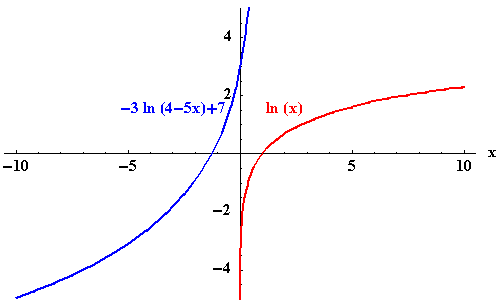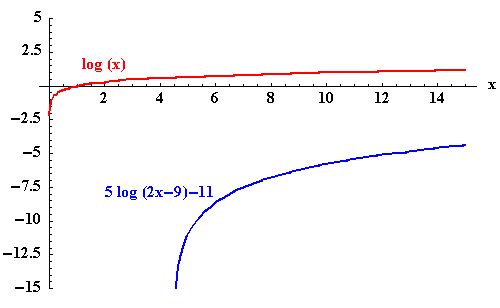 GRAPHS OF LOGARITHMIC FUNCTIONS
GRAPHS OF LOGARITHMIC FUNCTIONS

In this section we will illustrate, interpret, and discuss the graphs of logarithmic functions.
Combination of stretch, shrink, reflection, horizontal and vertical shifts. The following examples discuss the difference between the graph of f(x) and Af(B+Cx)+D. When A is negative, there is a reflection across the x-axis. When C is negative, there is a reflection across the y-axis. If B does not equal 0, there is a horizontal shift. If D does not equal zero, there is a vertical shift.
Example 17:
Graph the function  and the function
and the function  on the same rectangular coordinate system. Answer the following questions about each graph:
on the same rectangular coordinate system. Answer the following questions about each graph:
- In what quadrants in the graph of the function
 located? In what quadrants is the graph of the function
located? In what quadrants is the graph of the function  located?
located?
- State the domain of both functions.
- What is the x-intercept and the y-intercept on the graph of the function
 ? What is the x-intercept and the y-intercept on the graph of the function
? What is the x-intercept and the y-intercept on the graph of the function  ?
?
- Find the point (e, f(e)) on the graph of and find (-e, g(-e)) on the graph of
 . What do these two points have in common?
. What do these two points have in common?
- Describe the relationship between the two graphs.
- How would you moved the graph of
 so that it would be superimposed on the graph of
so that it would be superimposed on the graph of  ? When you moved the graph, where would the point (e,1) on
? When you moved the graph, where would the point (e,1) on  be after the move?
be after the move?
- You can see that the graph of the function f(x) is located in quadrants I, II, and III The graph of the function g(x) is located in quadrant II.
- The domain of the function f(x) is the set of positive real numbers. The domain of the function g(x) is the set of negative real numbers.
- You can see that neither of the graphs crosses the y-axis; therefore, neither of the graphs has a y-intercept. The graph of f(x) crosses the x-axis at 1, and the graph of g(x) crosses the x-axis at -1.262452, rounded to -1.3 for graphing purposes. You could have determined the x-intercepts analytically without a graph. Note that Ln(x) = 0 when x = 1. Note that
 . This can be rewritten
. This can be rewritten  . This last equation can be converted to the exponential equation
. This last equation can be converted to the exponential equation  . When we solve for x in this last equation, we have
. When we solve for x in this last equation, we have  = -1.262452. .
= -1.262452. .
- The point
 is located on the graph of f(x). The point
is located on the graph of f(x). The point  is located on the graph of
is located on the graph of  .
.
- Even though the graph of g(x) looks difference from the graph of f(x), both graphs have essentially the same shape. The graph of g(x) results after you reflect the graph of f(x) over the x-axis, over the y-axis, shrink it, shift it to the right, and then shift it up.
- The graph of f(x) is reflected over the x-axis, reflected over the y-axis, shifts to the right, is stretched by 3, and then shifted up.
Example 18:
Graph the function  and the function
and the function  on the same rectangular coordinate system.
on the same rectangular coordinate system.
- In what quadrants in the graph of the function
 located? In what quadrants is the graph of the function
located? In what quadrants is the graph of the function  located?
located?
- State the domain of both functions.
- What is the x-intercept and the y-intercept on the graph of the function
 ? What is the x-intercept and the y-intercept on the graph of the function
? What is the x-intercept and the y-intercept on the graph of the function  ?
?
- Find the point (10, f(10)) on the graph of
 and find (10, g(10)) on the graph of
and find (10, g(10)) on the graph of  .
.
- Describe the relationship between the two graphs.
- Describe how you would move the graph of
 moved so that it would be superimposed on the graph of
moved so that it would be superimposed on the graph of  . Where would the point (1000, 3) on the graph of
. Where would the point (1000, 3) on the graph of  wind up on after the move?
wind up on after the move?
- The graph of f(x) is located in quadrants I and IV The graph of g(x) is also located in quadrants I and IV.
- The domain of both functions is the set of positive real numbers.
- Neither of the graphs cross the y-axis. Therefore neither of the graphs has a y-intercept.
The graph of f(x) crosses the x-axis at 1, and the graph of g(x) crosses the x-axis at 83.74466. 
- The point
 is located on the graph of
is located on the graph of  . The point
. The point  is located on the graph of
is located on the graph of  .
.
- Both graphs have essentially the same shape. The graph of g(x) is located below the graph of f(x).
- When the graph of f(x) is shifted to the right
 , stretched by a factor of 5, and shifted down 11 units, it will be superimposed on the graph of g(x). The point (1000, 3) on the graph of f(x) would be shifted to (1000,
, stretched by a factor of 5, and shifted down 11 units, it will be superimposed on the graph of g(x). The point (1000, 3) on the graph of f(x) would be shifted to (1000, ) = (1000,5.495356) on the graph of g(x).
) = (1000,5.495356) on the graph of g(x).
If you would like to review another example, click on Example.

[Exponential Rules]
[Logarithms]
[Algebra]
[Trigonometry ]
[Complex Variables]
 S.O.S MATHematics home page
S.O.S MATHematics home page
Do you need more help? Please post your question on our
S.O.S. Mathematics CyberBoard.

Author: Nancy
Marcus
Copyright © 1999-2024 MathMedics, LLC. All rights reserved.
Contact us
Math Medics, LLC. - P.O. Box 12395 - El Paso TX 79913 - USA
users online during the last hour
 GRAPHS OF LOGARITHMIC FUNCTIONS
GRAPHS OF LOGARITHMIC FUNCTIONS  GRAPHS OF LOGARITHMIC FUNCTIONS
GRAPHS OF LOGARITHMIC FUNCTIONS 
![]() and the function
and the function ![]() on the same rectangular coordinate system. Answer the following questions about each graph:
on the same rectangular coordinate system. Answer the following questions about each graph:
 = -1.262452. .
= -1.262452. .![]() and the function
and the function ![]() on the same rectangular coordinate system.
on the same rectangular coordinate system. 


 S.O.S MATHematics home page
S.O.S MATHematics home page 